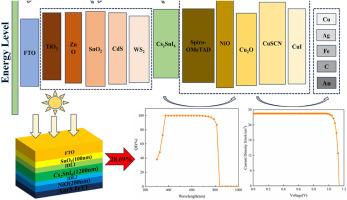An inorganic lead-free Cs2SnI6-based perovskite solar cell optimization by SCAPS-1D
IF 4.9
3区 材料科学
Q2 CHEMISTRY, MULTIDISCIPLINARY
引用次数: 0
Abstract
Cs2SnI6 is an environmentally friendly and reliable perovskite solar cell (PSCs) material. Its optimal band gap and strong light absorption make it a promising candidate for the absorption layer. However, the current challenge is to improve its photoelectric conversion efficiency. To address this, this study investigates the performance of PSCs based on Cs2SnI6 using SCAPS-1D simulation. The influence of various factors on PSC performance is examined, including different hole transport layers(HTLs) and electron transport layers(ETLs), perovskite layer thickness, ETL doping density, HTL doping density, absorber doping density, perovskite layer defect density, different back contacts and temperature. Finally, a Cs2SnI6-based solar device with an inorganic configuration of FTO/NiO/Cs2SnI6/SnO2/Au has been developed, reaching the power conversion efficiency(PCE) of 28.69 %. The study demonstrates that Cs2SnI6 PSCs exhibit promising photovoltaic performance, offering valuable insights for the solar energy sector in the production of cost-effective, efficient, and environmentally friendly Cs-based perovskite solar cells.

利用 SCAPS-1D 优化基于 Cs2SnI6 的无机无铅包晶太阳能电池
Cs2SnI6 是一种环保、可靠的过氧化物太阳能电池(PSCs)材料。它具有最佳的带隙和强大的光吸收能力,因此很有希望成为吸收层的候选材料。然而,目前的挑战是如何提高其光电转换效率。为此,本研究利用 SCAPS-1D 模拟研究了基于 Cs2SnI6 的 PSC 的性能。研究考察了各种因素对 PSC 性能的影响,包括不同的空穴传输层(HTL)和电子传输层(ETL)、包晶层厚度、ETL 掺杂密度、HTL 掺杂密度、吸收剂掺杂密度、包晶层缺陷密度、不同的背接触和温度。最后,开发出了一种基于 Cs2SnI6 的太阳能装置,其无机配置为 FTO/NiO/Cs2SnI6/SnO2/Au,功率转换效率(PCE)达到 28.69%。该研究表明,Cs2SnI6 PSCs 具有良好的光伏性能,为太阳能行业生产经济、高效、环保的铯基包晶太阳能电池提供了宝贵的启示。
本文章由计算机程序翻译,如有差异,请以英文原文为准。
求助全文
约1分钟内获得全文
求助全文
来源期刊
CiteScore
7.80
自引率
2.50%
发文量
605
审稿时长
40 days
期刊介绍:
The Journal of Physics and Chemistry of Solids is a well-established international medium for publication of archival research in condensed matter and materials sciences. Areas of interest broadly include experimental and theoretical research on electronic, magnetic, spectroscopic and structural properties as well as the statistical mechanics and thermodynamics of materials. The focus is on gaining physical and chemical insight into the properties and potential applications of condensed matter systems.
Within the broad scope of the journal, beyond regular contributions, the editors have identified submissions in the following areas of physics and chemistry of solids to be of special current interest to the journal:
Low-dimensional systems
Exotic states of quantum electron matter including topological phases
Energy conversion and storage
Interfaces, nanoparticles and catalysts.

 求助内容:
求助内容: 应助结果提醒方式:
应助结果提醒方式:


